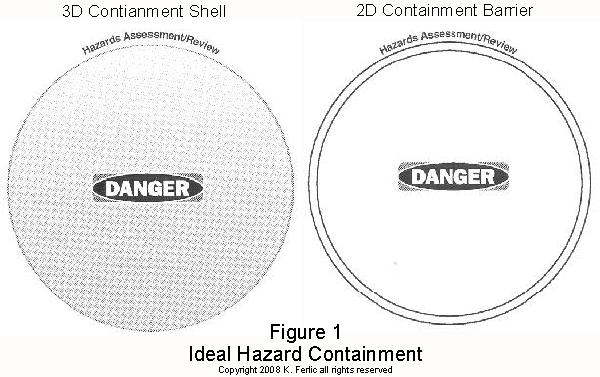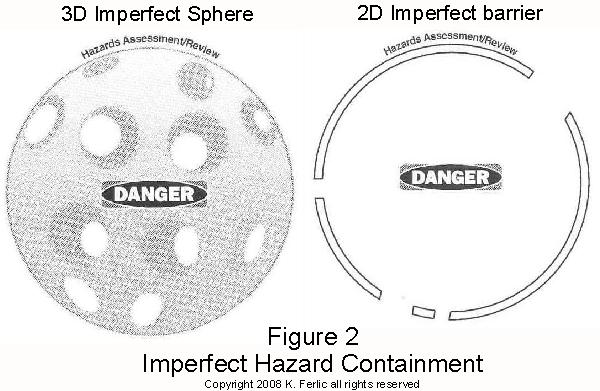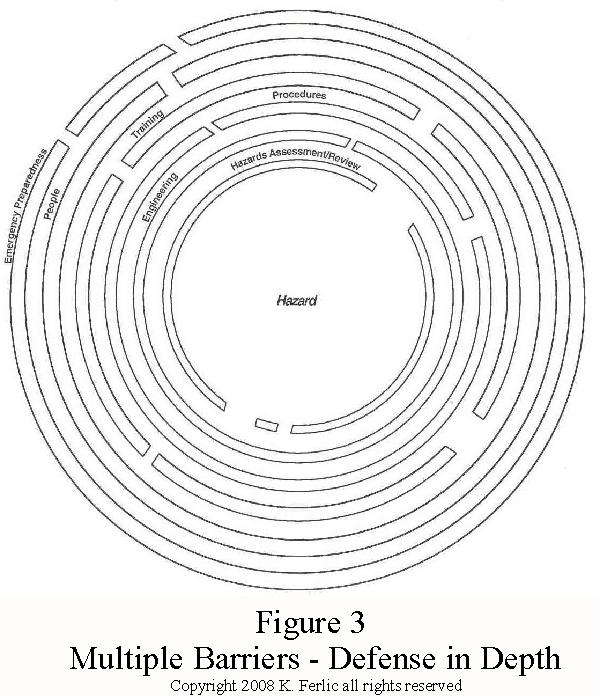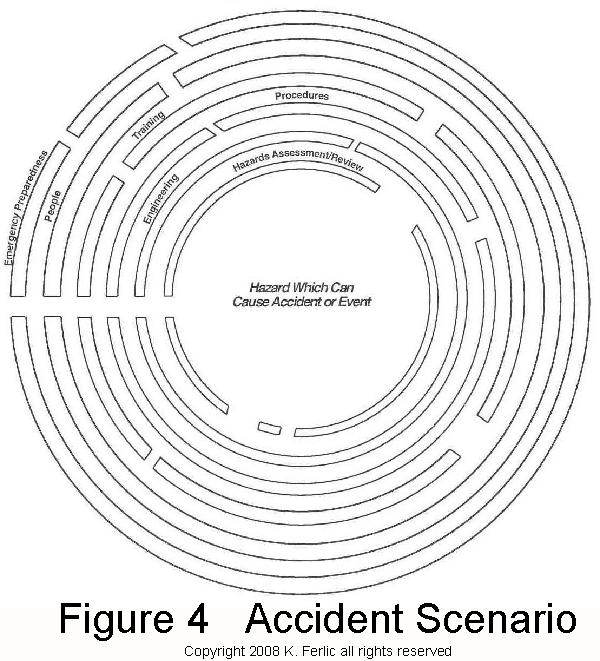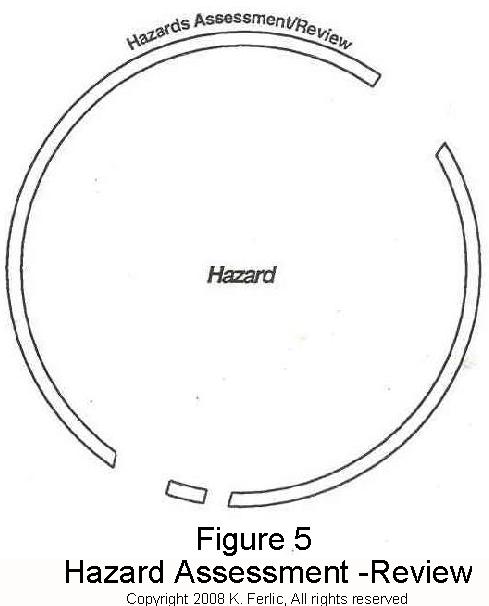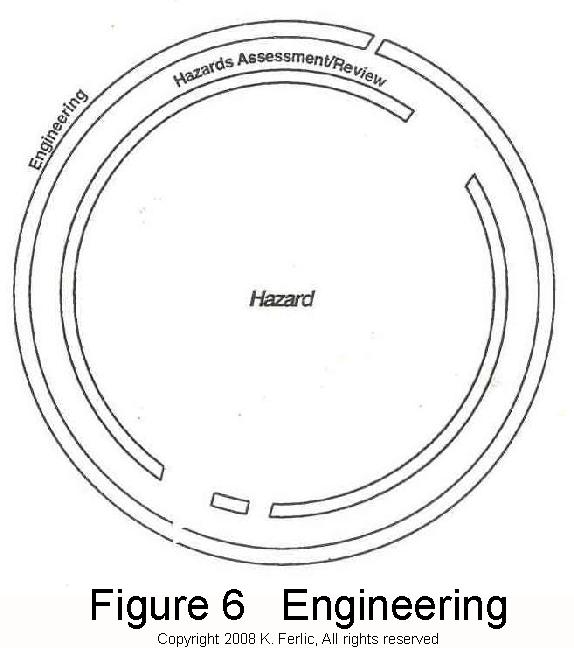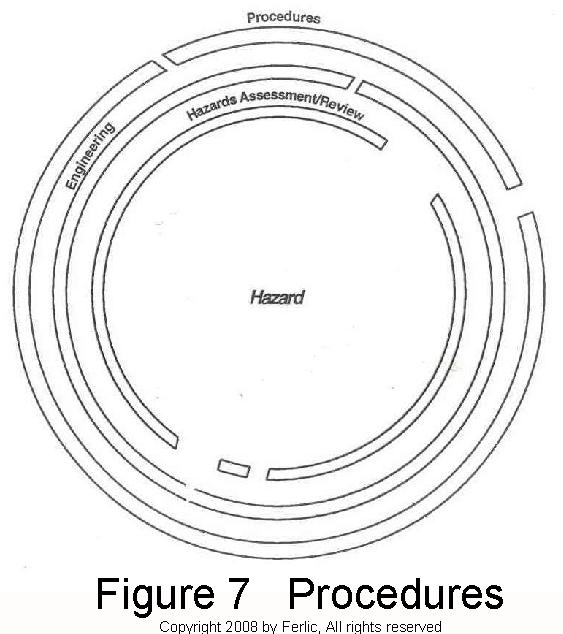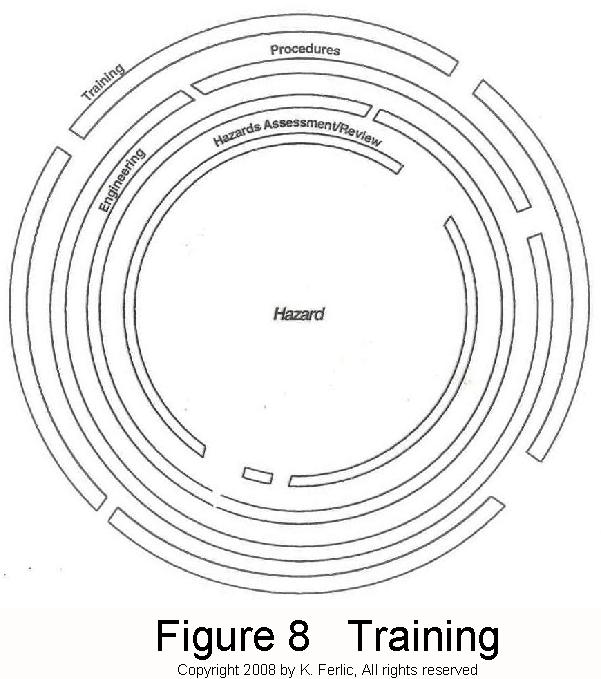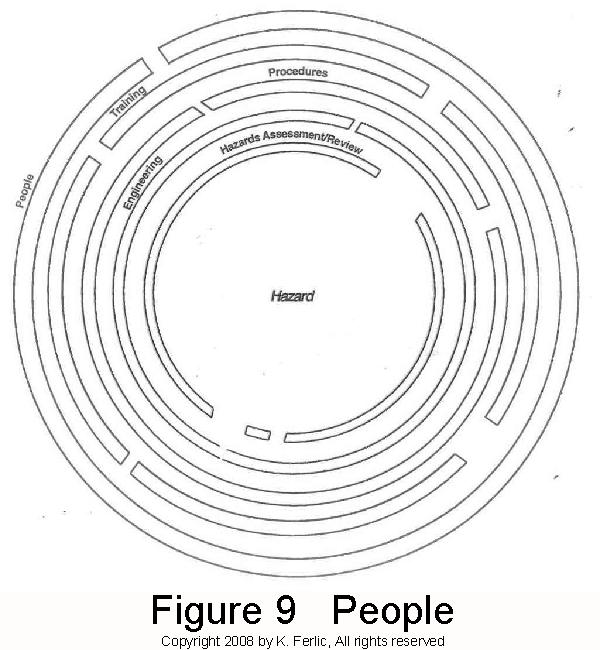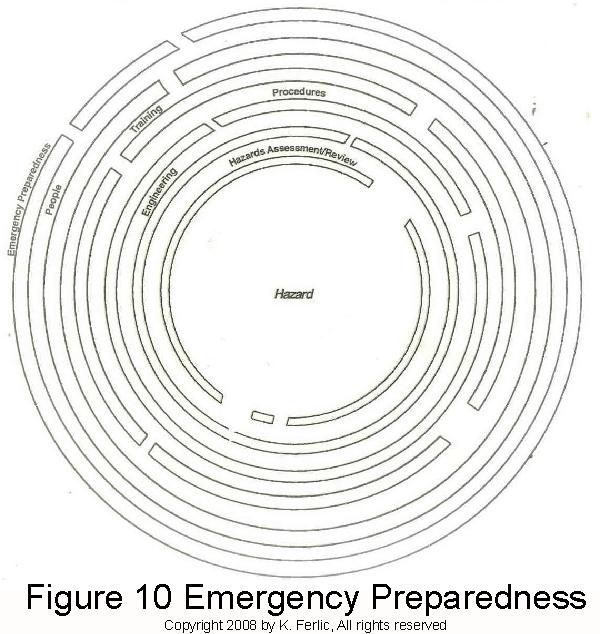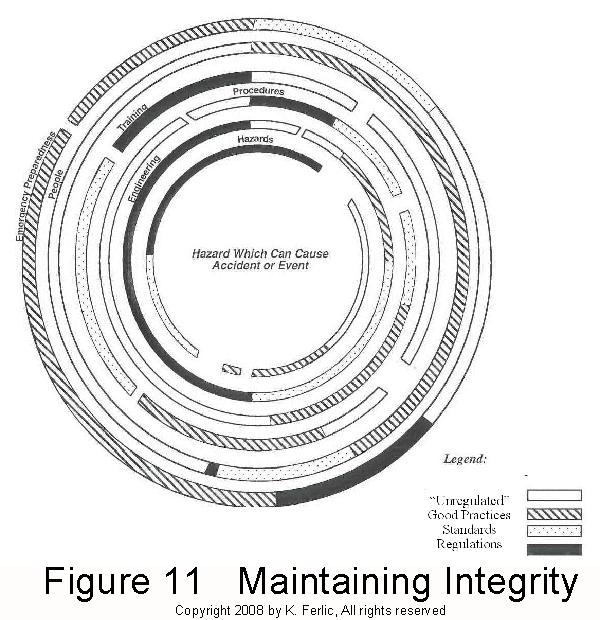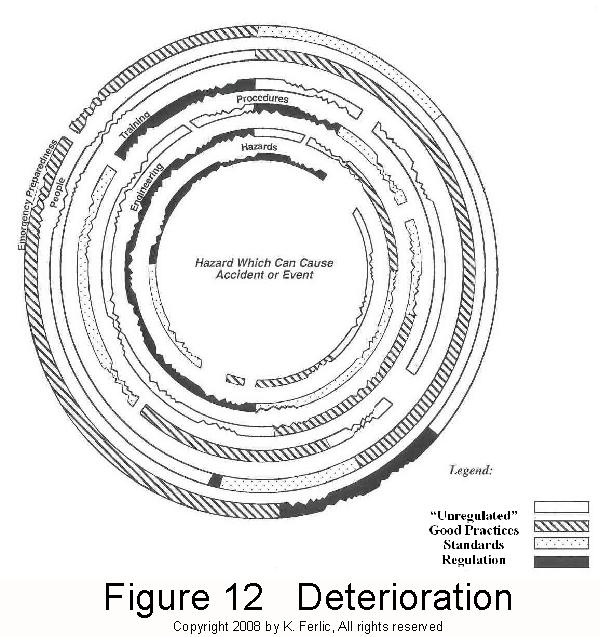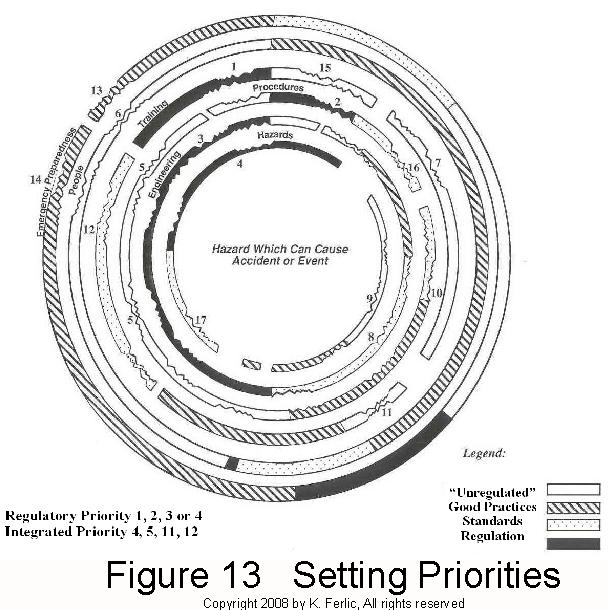|
|
A model for safety and quality |
|
A Releasing Your Unlimited Creativity discussion topic | |
|
Copyright 2008 by K. Ferlic, † All Rights Reserved | |
| RYUC Home Why free? Contact Links Programs Services Contributions | |
|
Many organization have activities that require the application of personal, public and/or environment safety considerations. The following model was developed within the Orchestrating the Organization framework that may be helpful in understanding what safety and quality is trying to achieve and why it seems so hard to ensure safety and quality even when one does everything that can think of doing, accidents still happen. Shell model for organizational safety and quality operations In trying to educate individuals on all the different aspects that need to come together to ensure safety of high hazards operation and yet understand how one could still have accidents such that an eternal vigilance was needed to ensure safety, a model was developed to help provide a perspective. The model is entitled the shell model or the safety barrier model. The focus of this model helps the individual understand what one needs to do to eliminate or mitigate a potential hazard whether that hazard could injure personal, damage facilities, affect the environment or impact the public in some way. The concept is quite simple and is applicable to any hazards and the approach taken. In using this mode, it become clear the model also laid out the essential elements for the quality or correct performance of any task performed by an organization. To shift from safety to quality, all that needed to change was rather than focusing on the endpoint of safety and eliminating a hazard, was to focus on quality and eliminating a defect or inadequacy. The shift is simply from trying to prevent a hazard from causing an injury to focus on the process to perform a task and preventing a defect or error reducing quality. In shifting focus, the model shifts from a safely application to a management tool to ensure quality operation in performing any task. As a management tool for organizational operations, each part of the shell model can be seen as a spectrum that runs the extreme from doing noting in a particular area to having a very formal and controlled program. How important any one part or particular area is depends on the task and how great a risk or loss is incurred if the task is inadequately completed. Original shell model of safety or the safety barrier model: The original shell model or safety barrier model was based on dealing with situation where we have a hazard, a hazardous or dangerous scenario of some type, or something that can cause harm to us or another in some way. The traditional approach to ensure our safety when facing hazards is to erect a barrier of some type between us and the hazard or change the chain of events we perceive that would cause the hazard to harm us. From a model perspective, we live in a three dimensional world. This means we can experience harm or injury from any direction. So, wherever barrier we place between us and the hazard, it must cover all possible direction. To cover all possible direction we can do one of two things. One is to put ourselves in some type and kind of protection armor or shell. Or, we can build the barrier around the hazard. In essence it is to create a shell around the hazard. If the hazard is completely contained/eliminated by the shell that we place around ourselves or around the hazard, we are safe or we are protected from the hazard. For the purposes of the shell or barrier model, we will place a shell around the hazards as in Figure 1.
In Figure 1 there is both a three dimensional and a two dimensional view. In the discussion we will be using the two dimensional view and it is import to not forget we are dealing with a three dimensional problem. That is, we need to look at all direction and proverbially, not what is just standing in front of us. It is to be noted that here lies the origin of the name of the model as the shell or barrier model. In two dimensions, there is a barrier around the hazard. In three dimensions it is a shell. Hence the names barrier or shell model. From a quality perspective we can do much the same thing The shell we place around the hazards for safety is about looking at all the ways the hazards could cause harm. For quality we create a shell around "quality" and look at all the ways that quality will not be achieved. Our problem in ensuring safety is we live in a world where we donít know everything about any particular issue. It is this very fact that gives rise to accidents. There is something we fail to consider that comes back a haunts us in some type of undesired occurrence. As a result, whenever we try and build a shell around any hazard to eliminate the hazard we perceive there is probably more than one hole in the shell. The hole in the shell is representative of what we donít know about the hazard. Or, it represents what we donít know about a particular scenario that will cause the hazard to cause us harm and how to protect ourselves from it. Instead of erecting a solid shell around our hazard the shell more looks like a wiffle ball or shell full of holes as in Figure 2.
The size of the holes in our barrier or shell vary and depends on what we donít know about the situation we face or the possible situations that could arise to cause us injury of which we are unaware. Ideally we put as much as we know about the hazard into the design of our shell. In doing so, we make whatever holes that exist as small as possible. The more we learn about the hazard and the possible scenarios that can cause harm and take action to do something to mitigate or eliminate the potential harm, the holes in the shell are closed or grow smaller. Additionally, since the world never remains static, we can perceive this shell constantly moving around the hazard so the location of the holes are not fixed. We never know when the hole appears just in front of us such that there is a hole in our protection and we are force to face the hazard. Since our shell has holes in it, to reduce the chance of being harmed, we can use multiple barriers or the equivalent of using multiple protective shells around the hazard. Although each shell has holes, the more shells you have the less likely the holes will align such that we have to face the hazard. These multiple shells are the defense in depth that we create to prevent injury or harm. We have different layers of protection where each layer covers a different aspect of the problem. As drawn in Figure 3, the traditional areas that we would address are an initial hazards review or analysis followed by, design and engineering of our protective systems, procedures, training, people, management philosophy and/or the formality of operations, and emergency preparedness.
Figure 4 represents how these various shell align to create an accident. That is no one defense is perfect. A accident occurs when all the holes in the shell align such that the "hazards escapes" to cause an accident, incident or injury of some type and kind. This is what gives rise to looking for accident precursors. Within this model, an accident precursor is just a hole in one of our barriers. The idea is whenever we find a hole in our barrier there is something which is not protecting us from the hazard as it should be, we patch the hole. By patching the holes as we find them, we reduce the possibility of the holes to align to cause accident or incident.
Translating the shell model for organizational operations: In translating this model to organizational operations we only need to realize what we do to mitigate or eliminate a hazard from a operation is no different that what we do for any other task we perform. That is, it is about looking and fixing things that are not working properly. Unfortunately, when it comes to safety and even quality, It is only when the risk of failure or loss that can be incurred because the task in question is inappropriately completed becomes so great that it is cost effective to put into place controls so that there is no failure or at least failure is minimized. The more controls that organization places on what they do that involved safety or quality, the more what is done evolves into a formal safety or quality function within the organization. Within the concept of Orchestrating the Organization, safety and quality should never be separated from the line management responsibility. Those who do the work need to be responsible for safety and quality. Safety and quality personal should be seen and used as advisors, consultants and contracts to assist the line organization. The line should never give up responsibility for safety and quality. Returning to the orchestra example, allowing the responsibility for the safety and quality functions to lie in an organization component other than the line is like saying the musician is not responsibility for the quality of the notes they play and/or the accuracy of their techniques in making music. Another musician can advise a musician as to how to improve their tone and techniques but it is the musician playing the instrument and making the music that is responsible for the music that is made. So too in the organization when it comes do ensuring safety and quality. It is line managementís responsibility and no one elseís responsibility. Relative to how much quality and safety is needs, from an organizational perspective we just need to ask, "How great a loss will we face is this task is not performed correctly or at all?" The anser to that question will give us some idea of the type and magnitude of the controls that we will need to be put into place. Of course, it is appropriate to note that material things can always be replace. The lose a life cannot. Analyzing the shells As stated above, the traditional aspects of safety and quality involve looking at our desired outcome and the hazards associated with what we desire. Organizations then translate that desired outcome into the design and engineering of the system they use to product that outcome. Since we are dealing with an organization, people need to know what to do so we develop procedures, plans and other types and kinds of guidance, rules or requirements. Give all that needs to be done, the personnel will need to be trained such that training and/or qualification programs are created. But, then we need to have people who have the necessary talents and skill to implement the plans, procedures and requirements we have. This involved creating selection criteria to hire people but also ways of filtering out those individual that cannot performed as needed. After all these programs and put in place, there is a management philosophy as to how business will be done Will management require a formality to operation and adherence to the plans and procedures or do they allow great freedom and latitude in what is done in the workplace. Managing creative endeavors will require a different approach than task which require very precise and accurate repetition of results. Then, depending on the hazards there may be the need for emergency preparedness just in case all the other controls for whatever reason fail. Each of these aspects are programs unto themselves and have different requirements and considerations. Each is briefly over viewed from the perspective of this shell or barrier model and considerations provided. The hazards reviews or hazards analysis: For any desired outcome or for any task or operation an organization decides to undertake, there needs to be a hazards review or hazards analysis. The hazards review or hazards analysis is the first step and it is reflective of the first shell of the model as drawn in Figure 5. Unless one consciously looks to see what hazards may exist in what is to be undertaken, one will never be able to protect themselves from those hazards. The hazards review or hazards analysis is the identification of the hazards that are perceived as capable of causing harm or injury. The goal is to create a create a safe space whether it be a safe facility or a safe operation to do whatever it is we desire to do. To do this, one needs to identify and look at each hazard and the multiple ways or the scenarios that injury or harm could be caused from that hazard. Once the possible scenarios are identified, those that have a real possibility of occurring (those of the greater risk or probability of occurring) are further studied to see how they can be eliminated or mitigated. Once the possible mitigation and/or elimination steps are identified, the next part of the process is to put into place those features that will eliminate or mitigate the hazards. However, the level of protection provided in this effort is only determined by how good a job we have done at identifying the hazards and understanding how they can harm us. If we have done a thorough and accurate review, we will have identified all the hazards or those that are significant in causing injury. For very high hazards, the review will be quite extensive and formal. For low hazards, there may be little to know review. How much of a hazards review we do will be determined by how safe a space you desire to create. Here it needs to be noted that the hazards review should not be limited to the nonhuman aspects as to what is done. We also need to understand the expected level of perform of the individual how will preform the task and/or maintain the system we are putting in place. Whether we consciously realize it or not, along with desiring to perform any task, there is the issue of the human performance which goes with the task. The question which needs to be asked along with the hazards review is what is the desired organization performance in the task to be undertaken. From a organizational perspective, there are two issue. The first is why we wish to do what we do and the second is how do we wish to do it. The first issue is about becoming very clear on what we wish to accomplish. The "why" behind what we wish to accomplish what we do. That is, we need to check to see if what we plan to do matches the why behind the actions. For example, we say we plan on creating a financial institution to make money and begin to look at the hazards and risk of our operation. If the why behind the desired action is to be happy in life - assuming money will make us happy, we will approach the risks and hazards we face quite differently than if the why behind our actions is to access the capital to build houses. Clarity of intent is extremely important in anything we attempt to do in life. If what we do does not reasonably align with our reason for acting we are asking to both split our creative life energy reducing our available creative power and create a hole in our protective shield we are attempting to create around the hazard. Often we overlook inherent hazards in what we are doing for our focus is not on what we are doing but directed elsewhere. The second issue is how we are choosing to attempt to do what we desire to do. Here we need to look at what we wish to accomplish and the ways that are available to us to accomplish it. We cannot and should not assume our initially selected way of acting is the best way to act especially from a hazards perspective. An efficient and cost effective process starts with a proper design and a proper design is based on a particular choice or way of creating what we desire. If we thoroughly look at all our options for the situation as it currently exists, incorporate lessons learned of others and we understand it and look at how we foresee it evolving over the lifetime of the operation or task, we can choose that solution that looks like the best path available. How much a review we do to look at options is, of course, determined by how important what we are attempting to do is and how important its success is to us. How complex a task we are choosing to do will determine how much formality we will use in the review. How much we do at this stage is all determined by how important what we do is to us and how much assurance of success we need to have. The better the hazards review the better the chance of our success. As seen in Figure 5, there will most probably be something we have either overlooked or do not foresee that creates a hole in our shield. Overlooking hazards is usually a result of our focus. As said above, if what we desire to do is different than the reason behind our actions, we will overlook hazards. This is why if it often good to have another individual review what we propose. Since their focus is different, they often see things we overlook. Here again, clarity of intention goes a long way in adequately seeing the hazards we may face. If we are involved in a true creative endeavor, the very nature of what it means to create will result in things that we do not foresee. However, all creation usually result form the marriage of two parents. That is, there is something we do based on want we think and believe that is not giving us what we desire in the environment in which we find ourselves. One part of what we desires is based on what mind wants and is not getting. In this case, mind is one parent. The second part is our environment is not giving us what we what. The environment is the second part. If we look at the hazards our mind normally causes to arise we can expect our mind to repeat the past in some way. For example, anything that requires a high degree of balance spiritually, mentally, emotionally or physically can more likely result in us falling out of balance with the associated consequences. Similarly we can look at our environment and see what types and kinds of hazards it present it will give us some idea of what we can expect in the future. For example if we choose to build a facility in a river valley, there is the question of how often does the river flood and when it floods will it affect our facility and its workers. By looking at what gives rise to any creative endeavor, we can actually see into what we may expect as to hazards.
Design and engineering The second step in the creative process is the design and engineering that goes into what we desire to do. As seen in Figure 6, design and engineer builds the second protective shell. After identifying the hazards and the ways that can be used to eliminate and mitigate the hazards, as many of these ways are built into the design of facility. In design we design some type structure that will capture as much of the process or task that we desire to create and design some type of containment or protection to prevent and/or mitigate the hazard from causing harm. In engineering (construction phase) we build the actual buildings and facilities and install the equipment that will allow us to accomplish what we intent to do. This is the engineering solution. We use what we know about the hazard scenarios and the physics or engineering of the situation, that is the "rules" or principles that govern the situation, to construct some type and kind of structure that prevents the hazard from causing harm. The engineering solutions either contain the hazards or prevent the identified scenarios that can cause harm from occurring. As long as the engineered solutions remain in place as designed, the hazard will be prevented from causing harm. How much of a permanent building or equipment we build is determined on what you desire to accomplish. Often it is easier, cheaper and more efficient to build certain types and kinds of special equipment even for one time use than it is trying to make do with something designed for another function. However, to keep the engineering solutions in place we must both maintain those systems and ensure they do not somehow change. If we discover a new hazard scenario, we would back fit any necessary engineering solutions to mitigate or eliminate the new hazard scenario. In doing so, we will need to ensure the original design and engineered solution is not somehow mitigated or degraded. Ensuring the original systems design and incorporation upgrades takes us into organizational design. That is, we need to design our organization such that there is a adequate engineering competence in some way to be aware of the maintenance and surveillance requirements and appropriately ensure they are maintained. In this regard, organizational design and engineering is the second half of the design and engineering phase. As long as the engineered solutions remain in place as designed we will be able to do what it is we desire to do. However, it needs to be noted and emphasized, no matter how good our design and engineering may be, there will almost always be something that is overlooked or lacking. There will be holes in our shell no matter how hard we try to ensure everything is covered. This does not mean we stop looking to make it the best design and engineering possible. The more we look the more we will find and the better the defensive shell we put in place. This realization also reveals the need for additional protective shells.
Role of procedures: The third step in the process and is reflective of the third shell as in Figure 7. It is to develop procedures or ways of working for two reasons. One reason is to ensure quality operation and the systems are used as appropriate and as necessary. They are used to ensure the maintenance of the safety systems and working with, handling, or be around the hazards are done in a safe way so as to not cause harm or injury. Safety related procedures perform sever important types and kinds of functions and there will be a spectrum in what is developed. The spectrum ranges form little to no formalized procedures to very a formalized procedures and control systems where everything is documented and controlled. What is done is determined by the magnitude and size of the hazard one faces. The major types of procedures are maintenance, surveillance and operational procedures. To ensure the integrity of the design and engineering solutions to mitigate a hazard, there is a certain maintenance that must be done. The maintenance aspect to the procedures encompasses the procedures that one would use to maintain the engineered features as designed. It would include a parts pedigree program to ensure equivalent replacement for any repairs that are done. It would look an any change to the exist structures or systems to ensure the design base and engineering assumptions are maintained. The maintenance procedure system would include a way to control drawing to ensure there is always an "as built" set of drawing reflective of the facility and equipment as it currently is and not how it was years prior. The maintenance procedures would also include a "back fit" program so that there is away to go back and redesign or upgrade the existing structure and systems as new more current information is made available yet ensure and maintain the safety. Closely related to the maintenance program is the surveillance aspect. Surveillance includes routine or periodic observation of the existing facility, systems and structures including organizational structures to see that they are not somehow being degraded or compromised in some way. Materials can change either though routine "wear and tear" or weathering, and sometimes new and unexpected scenario begins to emerge where the material are not performing as expected. Unless one is looking to maintaining the systems, over time the systems can fail. On this note, the procedures would include a way to ensure the existing design based is not intentionally or accidently changed without some type of safety review. The safety review is to verify that whatever is changed is fully understood and does not cause a new hazardous situation or otherwise increasing the potential for harm. The surveillance program should look for "unreviewed safety questions." That is, are their operations or activities that are actually going, or have the potential to go, outside the facilities, systems and structures as designed. The procedures would also include how to handle the hazard or deal with any scenarios that could not be fully eliminated or mitigated by engineering solutions. Often a hazard or scenario exists such that engineering cannot and will not give a complete solution and we must rely on knowledgeable and skilled personnel to work with the hazard in a way that is safe. Here it is essential the procedures include a way of incorporating lessons learned and if anything does go wrong in any aspect of operation whether it be in maintenance, surveillance, operation or there is an unexpected anomaly the event is captured and understood. To have an effective lessons learned program, any operation that is performed should be critiqued formally or informally to see if actions taken were adequate, exceeded expectations or unexpected difficulties were encountered. The critique process needs to be able to captured what has occurred and can input the finding into the lessons learned program that are captured and properly rolled into whatever aspect of the program that is applicable such as design or procedural changes. On the note of anomalies, there should be some procedure or way to direct personnel when, for some reason or another, the procedures are rendered inappropriate, inadequate, or one is being forced to step out of the procedure. Stop work authority and new directions needs to be available but, and/or, immediate cessation of operations may or may not be appropriate. Whatever is being done must be put into a safe configuration and there will need to be a way to allow individuals to safely configure the situation to be able to stop work and go figure out what exactly is wrong. In all cases procedures if they are used should be clear and unambiguous , concise without excess verbiage, written, controlled so that we know we have the most current version, complete, reviewed and approved. Here again, how formal a program exists all depends on the hazards that are faced and the risk if the procedure is not followed or errors are made. Organizational related procedures and quality control procedures parallels the safety related procedures. There is the need to have maintenance, surveillance and operational procedures , or their equivalent, with the same type and kind of programs in place. The greater the potential loss or impact because of failed performance will determine how extensive a program that needs to be developed. As for engineering and design, no matter how good our procedures may be, there will almost always be something that is overlooked or lacking. There will be holes in our shell no matter how hard we try to ensure everything is covered. Again, this does not mean we stop looking to make it the best procedures possible. The more we look the more we will find and the better the defensive shell we put in place.
Role of training: The fourth step in the process is training and reflected in Figure 8. There are two types of training to maintaining the barrier. There is safety training and organizational training. Safety training normally has two parts. One is safety training where personal are trained on the hazards that exist in the workplace and what they need to know individually about how to face or deal with the hazards to which they may be exposed. The other it training to qualify personal or ensure a trained workforce to operate the facility and equipment. Although we may construct an excellent hazards elimination and mitigation system and we have exceptional procedures that can maintain the existing systems and handle any potential hazard, if personnel are not trained and understand what needs to be done, all will be rendered useless. To be complete and yet cost effective, training should be systematic and performance based on actual needs of the task that will be performed. A formal or informal job task analysis may need to be performed to ensures the knowledge, skills and abilities necessary to do the job in an effective manner are captured and incorporated into the training. Everyone does not need to be trained on everything thing but the greater the understanding and individual has about what they do and why, the better able they are able to recognize when something is not correct. Training would include appropriate "hands on" experience, simulation, and other techniques to ensure the individual has both the mental understanding and the practical experience and experiential knowledge to do whatever task that needs to be performed is done so safely and in accordance with the procedures and the design base. The actually method that is used to provide the training, for example formal classroom, required reading, mentoring and/or coaching, self study or whatever, is less important than what is effective and the individual gets the necessary knowledge, skills and abilities they need. Organization training also has two types of training. Not everyone in the organization will work to produce the product or service. There are many support personal that assist others. These personal will need to know and understand how their jobs support the overall mission and function of the organization. If their jobs are really important, then their job must be done in a way that helps achieve the over mission and they need to know and understand how important their job really is and why. For those engaged in one way or another producing the produce or services, they will need to be fully trained and capable of performing their task in accordance with procedures to a level that parallels safety. Here again now formal a training program and how rigid the training depends on how import the task that needs to be done. As with every other shell, training too will have areas or aspects where something is not seen, overlooked or lacking. There will be holes in our shell no matter how hard we try to ensure everything is covered. Again, this does not mean we stop looking to make it the best training possible. The more we look the more we will find and the better the defensive shell we put in place.
Role of people The fifth protective layer as presented in Figure 9 is about people. Simply said, any organization needs to have the right people and the issue with people is ultimately about four things. That is, they are the mindful, aware, understand what they are doing, and have a supportive attitude for what needs to be accomplished. To put all the requirements in place for any operation, the organization needs to have people who are capable of performing to the level of required performance. They must be have the knowledgeable, skills and abilities or are capable of obtaining the necessary knowledge, skills and abilities through the established training program. However, having the necessary knowledge, skills and abilities is not always sufficient. Motivation and attitude are just as important. If the individual is not willing to follow the procedures and work to ensure the overall success of the operation in a way consistent with the philosophy of operation they will not necessarily be an asset. One needs to have the motivation to do what needs to be done and ensure the correct action is done and if they are unsure of the correct action they go find out what the correct action is. Similarly, and maybe somewhat ideally, it has been found in the exploration of creativity in the workplace and the subsequent exploration of our inherent creativity, the individual should believe in what they do and what the organization does. Ideally what they do should in some way be in alignment with the intention for their life and what their creative spirit desires to create. When this occur, their attitude will be proactive in that they are attentive to what needs to be done and why so that they can help to identify when the existing situation are just not correct and some corrective action needs to be taken. It is to be noted that originally, when job task analysis was initially developed, the analysis included knowledge, skills and attitude. However, attitude was found to be very subjective and hard to quantify especially from a legal perspective if an organization was going to deny a person a job because of "attitude." The question organizations faced was "What method could one use to evaluate and really know a personís attitude to know if the individual does or does not have the right attitude for a job if you are in the process of hiring them?" Of course, after the individual is hired and they perform within the organization, the organization has a much better understanding of their attitude. But here again, an individual cannot be dismiss simply based on attitude. Unless it can show how the individual is causing some type of injury or harm, not fulfilling the performance based requirements for the job, disrupting the workplace in one way or another, attitude in itself is not a cause for dismissal. Yet it is oneís attitude that ultimately determines if one will or will not be successful at what they choose to do. Although people are the organizationís move valuable asset, they also can also give rise to some of the biggest problems an organization faces. Other protective shells, will have areas or aspects where something is not seen, overlooked or lacking. Although these types and kinds of things exist with people, the issue with people they are not always consistent. The challenge with people is to keep mindful and aware of what they are doing. As stated about it has been found that when the desires of the creative spirit are aligned with what an individual does, they will be mindful and aware to the degree necessary.
Role of emergency preparedness The sixth shell as reflected in Figure 10 is emergency preparedness. Emergency preparedness deals with preventing and mitigating loss when something goes wrong. Although it is clear how emergency preparedness is needed for safety and hazardous situation, often the need for emergency response component is not as clear. Many see emergency preparedness as removing the need for an emergency response component. But any organization needs to ensure it can be response to the emergency for which they are prepared and both components need to be addressed within the emergency preparedness shell. From a safety perspective emergency prepared includes all of the above shells and then some. Emergency preparedness need to have the requisite engineering done in that one has to have the right equipment for the job such as respirations, fire retardants, fire truck, and other materials unique to the hazards faced. Procures include maintenance and surveillance of the emergency preparedness program and equipment plus the operational procedures to deal with the identified potential emergencies. It includes training and qualification of personnel to give them the necessary knowledge, skills and abilities to response to the potential emergencies. Emergency preparedness includes the selection of the right people who are capable and willing to response to whatever occurs. Relative to emergency preparedness, as a minimum, management understands and embraces what needs to be done and the management staff is capable of stepping in and assuming responsibility when the situation goes outside of what has been designed. Now the important thing to understand about emergency preparedness is that if we going to have some type and kind of catastrophic emergency it will probably be different than what we are capable of planing to occur. The logic is quite simple. If we can truly anticipate the accident we will have, we will have done all that is possible to eliminate or mitigate that scenario. So one of two possibilities will exist. Either we have an event in which we never conceived of existing or we have significantly degraded our existing protective systems such that we do not have the protective feature available that we though we had. In either case we have entered the unknown and we will have to have some cadre of personal trained to look beyond the existing situation such that they are capable of thinking out of the box when necessary. From an organizational perspective, this last statement is what is really needed for the viability and long term survivability for any organization. That is, the ability to enter the unknown. Each organization will need to have some one, or a group of individuals who are intimately knowledgeable to what is done such that whenever the organization enters the unknown, the individual are capable of looking beyond the existing situation as it unfolds and can think out of the box to arrive at viable solutions. Whether there is one group of individuals or a collection of people knowledgeable in different aspects of the organization who can think out of the box doesnít matter. There just needs to be someone who can see beyond the existing form and understands why the existing form exists as it is. They will then be the ones that we can consult with if we run into difficulties.
Role of the management philosophy and formality of operation The seventh step is about management and the accepted philosophy of operation that management demonstrates by example and through an ongoing organizational dynamics. In looking at all the Figures 3 through 10 one will notice there is no shell for management or the formality of operation. Yet the role of management is probably one of the most important. The following discussion reflected in Figures 11, 12, and 13 reflect the role of management. In most cases it is ultimately management that will make or break an organization. The issue of management is where are the priorities of the individual managers. Do individual priorities coincide with the organizational priorities. This layer of protection was not initially recognized as part shell model for safety nor its impact or on the organization. There was a naive assumption that when an individual was place in a management role, they would function as that role required. However, too much evidence such as that found in creating and using the Laboratory Integrated Prioritization System and in organizational oversight was seen to support that statement that most manager have a private agenda that is the basis of why they become a manager in the first place. Often that private agenda does not have the organizations best interests as the priority. The more common priority is the individualís ego, in one form or another. Most managers will do what the organization ask so as to not loose the position they have. But it is not loyalty to the organizational mission that is driving many managerís actions. The fact that private agenda exist is not necessarily good nor bad for some of those agendas have caused many organizations to perform extremely well. Rather, it just needs to be recognize that there is a private agenda and one only needs to be aware of when the private agenda is overshadowing the organizationís best interest. It is rather apparent that some management styles and some philosophies of operation are better suited for high hazard operations than others. That does not mean one cannot make any management style and any philosophy work. Rather it just means that a particular management styles and or philosophy of operation foster particular types and kinds of workplace attitudes and will ultimately draw or push away certain types and kinds of people. There is a self selecting process that begins to develop under any organization structure. Additionally some manage styles and philosophies of operation make a particular job or organization much easier and less likely to produce accidents. What needs to be realize is that those styles and philosophies that promote the combination of mindfulness, awareness and knowledge of the task at hand are more successful to high hazard, high quality and efficient operations. The reason for this is organization styles that foster these kinds of workers will catch things and act to correct them before they become significant. What this also means is there be more of an openness to look at the situation as it is and to receive bad or disappointing information followed by the motivation to address what is discovered. Maintaining integrity Maintaining integrity is the title of Figure 11.It is about management creating an organization systems which maintains and improves the overall safety. Maintaining integrity is about the ideal versus real operation. In ideal operations, everything runs as designed and expected. However, as we all know, in reality, events do not always go as expected. Things tend to degrade over time and people change and or respond unexpectedly. Additionally there always seems to be more demands on time and money that is available. There will be a never ending set of priorities that compete for limited resources. However, it is essential that there is a constant focus on maintaining the facility, processes and organizational structures as designed or become consciously aware of how and why you are changing that design. If attention is not give to "stay on course" in alignment with the chartered mission and the designs that go into implementing that mission, the organization will get out of phase with reality and start to flounder. To help ensure the design is maintained for whatever the organization does there are some systems that help to control and maintain focus. In any activity that is also performed by other people or organizations there are commonalities that have been developed and are often readily shared unless proprietary information is somehow involved. These commonalities can be grouped into four areas. There are unregulated practices, good practices, voluntary standards, and rules and regulations. All have been developed based on the experience of the past and lessons learned that can help an organization not repeat the past mistakes of others. Figure 11 has each shell shaded with these four types of practices reflective of how they are being used to maintain the shell. Unregulated practices: Unregulated practices are common practices shared by a group of individuals collectively or apart who do the same thing. Business tipping of waiters and waitresses would be an example a shared unregulated practices. Good practices: Good practices are practices that are followed by individuals or a collective who do the same thing that has been found as a beneficial way to do business or perform a certain type and kind of task. A good practice of most sound personal investment strategies is to pay yourself first and always invest something before you pay all of your other bills. Standards: A standard is a practice where were a group of individuals who perform in a common area have gotten together and came upon an agreed set of principles, actions or ways of doing business. Many certification programs are based on implementing a basic set of standards such that those are certified will do their practice in a particular agreed upon way. Rules and regulations: Rules and regulation are practices and ways of doing acting that have been codified in laws such that they may carry civil or criminal penalties. For one reason or another it was felt that there needed to be very clear and defined ways of acting in the governed situation. All of these four types of practices have been in one way or another based on lessons learned and it is always wiser to learn from the mistakes of others than to have the lessons yourself. So it only makes sense that any organization will want to follow as many of the accepted practices as possible if they desire to ensure hazards are contained and improve operations. It is managements responsibility to ensure its operations use the best practices possible. In most organization management directs maintenance of existing requirements, improvements and upgrades. In a responsive organization its members will continually be looking at ways to improve all that is done and bring to managementís attention anything that is not correct or out of the norm.
Deterioration of existing systems and programs Figure 12 is drawn to represent the deterioration of existing protection over time and/or when attention is not given to look to see where systems are being degraded and/or maintenance is not being maintained. It needs to be realized, organizations were designed and structured in a particular way and a reason exists for all the facilities, procedures, processes and the like. Existing systems and components must be maintained. If they are no longer as functional or as necessary as they once were, they should be replaced with something which maintains the same or better level of protection and effectiveness. This is one of the key responsibilities of management and management should ensure a level of formality of operations to ensures systems and maintained as designed. Or, if they need to be changed for whatever reasons, changed within a safety and quality review to ensure what is done does not lower the effectiveness of the protection.
Setting priorities Figure 13 provides a view as to how one may go about setting priorities. The primary concern should be to fix those areas that will cause a deterioration and erosion of the level of protection such that a hole is open in a protective shell. The more degraded the existing structure becomes the greater the change of a break in the protection level. From a safety or quality perspective the priorities should be determined by fixing the deteriorated conditions that offer the greatest possibility of creating a hole in the shell. However, regulatory concerns and/or personal preferences often determine the priority. There is always an issue of identifying and meeting the true organizational needs. The wisest approach appears to be to maintain systems as designed. Remove what is no longer effective or necessary only after an adequate review of the concerns that were the cause of its original incorporation. Continually look to continually improve cost effectiveness, quality and safety and ensure any changes made are adequately reviewed to ensure the equivalent or a better level of quality and safety.
Related topics The Password Protected Area provides access to all currently posted (click for current loading) Releasing Your Unlimited Creativity related discussion files and applications. |
|
|
RYUC Home Why free? Contact Links Programs Services Contributions | |

